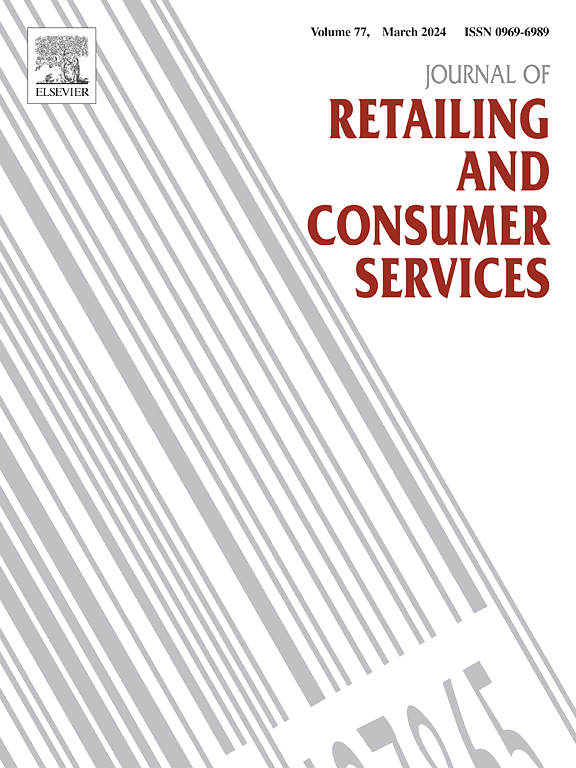声誉与价格:基于线索诊断理论的顺序推荐
IF 11
1区 管理学
Q1 BUSINESS
Journal of Retailing and Consumer Services
Pub Date : 2024-11-24
DOI:10.1016/j.jretconser.2024.104157
引用次数: 0
摘要
顺序推荐已被广泛应用于电子商务平台,以有效捕捉消费者的动态偏好并为其提供首选产品。传统模式通常使用评分和产品属性进行顺序推荐,以满足消费者更加个性化的需求。消费者在做出购买决定之前,也会依赖其他消费者的评论来形成对产品或零售商的总体印象。这些印象可被视为产品或零售商的声誉。受线索诊断理论的启发,我们将与产品购买相关的属性分为低范围线索和高范围线索。高范围线索(包括声誉)不易改变,因为它们是由众多消费者长期形成的,而低范围线索(如价格)则很容易被零售商改变。我们提出了一种创新的整合低范围线索和高范围线索的顺序推荐模型(SRILH)。我们设计了一个线索提取层,用于从消费者的在线评论中提取高范围线索;还设计了一个分层线索感知注意层,用于学习低范围线索和高范围线索的共同作用。我们使用三个真实世界数据集评估了所提模型的性能,实验结果验证了其有效性和鲁棒性。我们的研究揭示了线索对消费者行为的共同影响,并对推荐系统中线索偏好形成的动态过程提供了有价值的见解,从而为顺序推荐研究做出了贡献。我们还从微观和个体角度得出结论,阐明不同线索如何影响消费者的选择,从而扩展了线索诊断性理论的实证文献。可解释的可视化结果为零售商和制造商改进产品提供了管理见解。本文章由计算机程序翻译,如有差异,请以英文原文为准。
Reputation vs. price: Sequential recommendations based on cue diagnosticity theory
Sequential recommendations have been widely used in e-commerce platforms to effectively capture consumers' dynamic preferences and provide them with preferred products. Traditional models usually use ratings and product attributes for sequential recommendations to satisfy consumers’ more personalized needs. Consumers also rely on reviews from other consumers to form a general impression of the product or retailer before making their purchase decisions. Such impressions can be treated as reputations of the product or retailer. Inspired by cue diagnosticity theory, we divide the attributes related to product purchase into low- and high-scope cues. High-scope cues, including reputations, are not easily changed because they are formed over a long period by numerous consumers, whereas low-scope cues, such as price, can be easily changed by retailers. We propose an innovative Sequential Recommendation model by Integrating Low-scope cues and High-scope cues (SRILH). We design a cue-extraction layer to extract high-scope cues from consumer online reviews and a hierarchical cue-aware attention layer to learn the joint effect of low- and high-scope cues. We evaluate the performance of the proposed model using three real-world datasets, and our experimental results validate its effectiveness and robustness. Our research contributes to sequential recommendations research by uncovering the joint effects of cues on consumer behavior and by providing valuable insights into the dynamics of cue preference formation in recommendation systems. We also extend the empirical literature on cue diagnosticity theory by drawing conclusions from the micro and individual perspectives to shed light on how different cues impact consumer choices. The interpretable visualization results provide managerial insights for retailers and manufacturers to improve their products.
求助全文
通过发布文献求助,成功后即可免费获取论文全文。
去求助
来源期刊
CiteScore
20.40
自引率
14.40%
发文量
340
审稿时长
20 days
期刊介绍:
The Journal of Retailing and Consumer Services is a prominent publication that serves as a platform for international and interdisciplinary research and discussions in the constantly evolving fields of retailing and services studies. With a specific emphasis on consumer behavior and policy and managerial decisions, the journal aims to foster contributions from academics encompassing diverse disciplines. The primary areas covered by the journal are:
Retailing and the sale of goods
The provision of consumer services, including transportation, tourism, and leisure.

 求助内容:
求助内容: 应助结果提醒方式:
应助结果提醒方式:


